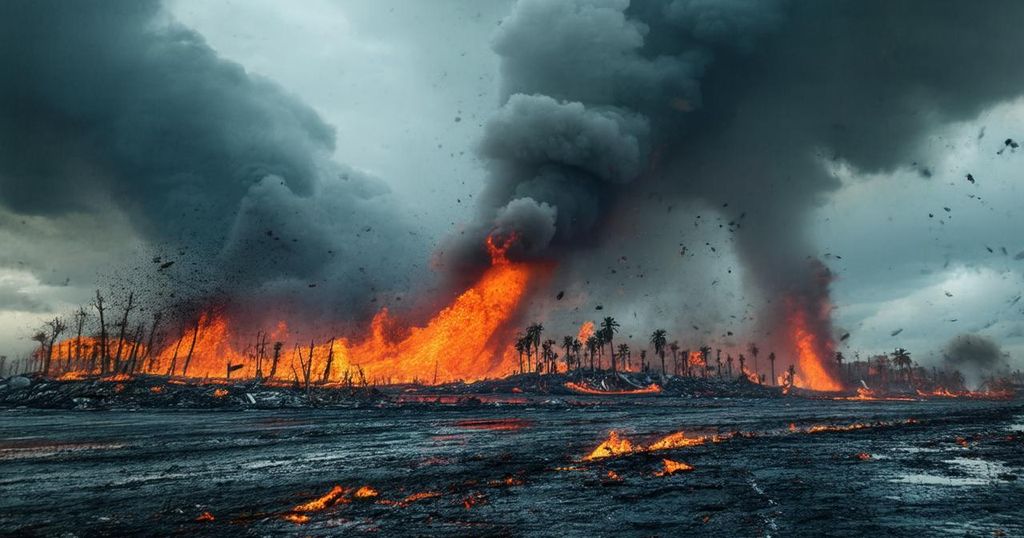Addressing the Climate Finance Gap in Fragile and Conflict-Affected Nations

In 2022, fragile and conflict-affected countries received only 25% of the climate finance needed to address their vulnerabilities, totaling $8.4 billion against a required $35 billion. These nations are significantly less funded per capita compared to more stable Least Developed Countries. As the global extreme poor population is projected to shift towards these areas by 2030, an urgent reform of climate finance practices and collaboration across sectors is necessary to support their resilience to climate change.
In 2022, countries facing fragility and conflict were alarmingly underfunded in climate finance, receiving only 25% of the necessary funding to address their immense climate vulnerabilities. Notable among these nations are Chad, the Democratic Republic of the Congo, Somalia, Sudan, and Yemen. These countries are among the 25 most susceptible to climate change while simultaneously displaying some of the lowest capacity for adaptation. Despite their urgent needs, the total climate funding allocated to these nations amounted to a mere $8.4 billion, significantly lower than their assessed climate adaptation requirements of $35 billion annually. Per capita, fragile and conflict-affected countries received considerably less climate funding compared to the global median of $84, highlighting a disparity that demands immediate attention. More stable Least Developed Countries and fragile Small Island Developing States received higher per capita financing. The World Bank anticipates that by 2030, two-thirds of the world’s extreme poor may reside in areas marked by fragility, conflict, and violence. The vulnerability of these nations to climate change is largely attributable to weakened state institutions, infrastructure destruction, and social disintegration, all of which limit their ability to anticipate, absorb, and adapt to climate hazards. It is paramount that funding entities, bilateral donors, and multi-development banks reform their strategies to prioritize climate resilience initiatives in these high-risk environments. At COP29, there is an urgent need to address the deficiencies within the climate finance framework that currently fails to support fragile and conflict-affected contexts effectively. This includes revising funding processes to accommodate the unique challenges faced by these regions and enhancing the capacity of local governments to manage and utilize climate funds efficiently. Furthermore, systemic reforms must be implemented to ensure that countries in dire need are not burdened with excessive debt in relation to the climate financing they receive. The call for a collaborative approach between development, humanitarian aid, and peacebuilding sectors must be heeded to move beyond mere crisis management towards a sustainable framework for climate resilience. At COP29, an actionable strategy must be established to cultivate cooperation with governments and communities in fragile regions, fostering context-specific climate resilience initiatives. Significant reform is essential to fulfill commitments to vulnerable populations and avert future climate-induced catastrophes in areas like Somalia.
The growing intersection of climate change, conflict, and fragility poses significant risks to vulnerable nations. Fragile countries often lack the institutional capacity to effectively address climate impacts due to ongoing conflicts and instability. This scenario worsens their vulnerability to climate change, requiring substantial financial assistance to enhance resilience. The limited climate finance currently directed towards these regions, in stark contrast to their enormous adaptation costs, highlights a critical gap in global climate action. Thus, addressing this funding disparity is imperative for both humanitarian and developmental outcomes.
In summary, the gap in climate financing for fragile and conflict-affected nations is not only a financial oversight but also an ethical imperative. The complexities of climate vulnerability and conflict in nations like Chad, Somalia, and Yemen necessitate urgent reforms in climate finance structures. The outcomes discussed at COP29 will be crucial in transforming the current landscape of climate financing, ensuring that the most vulnerable populations can begin to build resilience against future climate challenges. Without this shift, commitments from global institutions will remain unfulfilled, risking greater disasters in already precarious environments.
Original Source: odi.org






